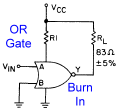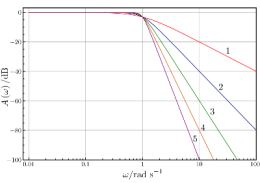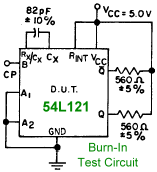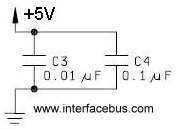Engineering Dictionary
"A"
"B"
"C",
"D",
"E",
"F",
"G",
"H",
"I",
"J",
"K",
"L",
"M",
"N",
"O",
"P",
"Q",
"R",
"S",
"T",
"U",
"V",
"W",
"X",
"Y",
"Z"
"B" to "Bas",
"Bat" to "Bim",
"Bin" to "Bn",
"Bo" to "Bq", "Br" to "Buq", "Bur" to "Bz"
Buried Via. A via hole which does not extend to the surface. A via that only runs between two internal layers. Additional terms related to PWB Definitions and topics.
Burn-In. The process of screening out marginal component parts by exposing them to elevated temperatures and voltage stress for a specified duration of time. This test is performed to eliminate marginal devices or those with defects resulting from manufacturing aberrations that are evidenced as time and stress dependent failures.
Without the burn-in, these defective devices would be expected to result in early lifetime failures under normal use conditions. It is the intent of this test to operate the semiconductor device at specified conditions to reveal electrical failure modes that are time and stress dependent. |
 Burn-in Test |
There are two types of Burn-In; Static and Dynamic. [When testing ICs] Static Burn-In ties all inputs high or low, while Dynamic Burn-In using incoming signals or clock to toggle the inputs [for the duration of the test]. The operation of an item to stabilize its characteristics.
Burnishing Tool. A tool used to clean and polish contacts on a relay.
Burst Error. A series of closely spaced errors occurring in a transmission channel caused by a common event.
Burst Transmission. Transmission that combines a very high data signaling rate with very short transmission times. Operation of a data network in which data transmission is interrupted at intervals.
Bus. One or more conductors or optical fibers that
serve as a common connection for a group of related
devices. More information on Bus Topologies. A line shared by more than one device or component so that information can be passed between devices. Note; a Bus is one form of a data network topology.

Common Bus Topologies
Bus Bar. A heavy copper strap or bar used to connect several circuits together when a large current carrying capacity is required.
Bushing. A Grommet or other insulating component used to protect a conductor passing through a metal panel. A hollow tube used to insulate a conductor. A vibration isolator. An insulating structure, including a through conductor or providing a passageway for such a conductor, with provision for mounting on a barrier, conducting or otherwise, for the purposes of insulating the conductor from the barrier and conducting current from one side of the barrier to the other.
Bus Transceiver. An IC or circuit that transmits and receives over the same lines using a direction control pin to control the flow of traffic. Also refer to the listing of Bus Transceiver ICs.
Button Capacitor. The shape of a type of capacitor. Read more on Terms used with Capacitors.
Butterworth Filter. The type of filter with a particular output response of either an active or passive filter. Refer to the definition of Filter for the different types. The graph shows the different orders of a Butterworth Filter, 1st order filter through a fifth order filter. |
 Butterworth Filter |
A filter that offers the flattest possible response in the passband. Also refer to Passive Filter Terms.
Bypass Capacitor. A capacitor used to transfer [Bypass] unwanted signals out of a circuit; for example, coupling an unwanted signal to ground. A capacitor connected across the power and ground pins of an IC. A shunt capacitor. Also called a Decoupling Capacitor.
Definitions only related to Capacitor related Terms.
Bypass Diode. A diode connected across a circuit or module such that the diode will conduct if the circuit become reverse biased.
Byte. [B] A sequence of adjacent bits (usually 8)
considered as a unit [character]. Ten bit bytes are also common, as in 8B/10B.
By-Wire. A "by-wire" term denotes a control system that replaces traditional mechanical or hydraulic linkages with electronic connections between control units that drive electro-mechanical actuators. Originally used in the aerospace industry as Fly-By-Wire; [Avionic Bus Descriptions], by-wire technology is making its way into the ground transportation sector, as Drive-By-Wire; [Automotive Bus Descriptions]. Automotive by-wire includes three categories: throttle by-wire, steer by-wire, and brake by-wire.
Byzantine Fault. A fault presenting different symptoms to different observers. An arbitrary fault that occurs in a system or bus that causes random or unpredictable behavior in the system.










